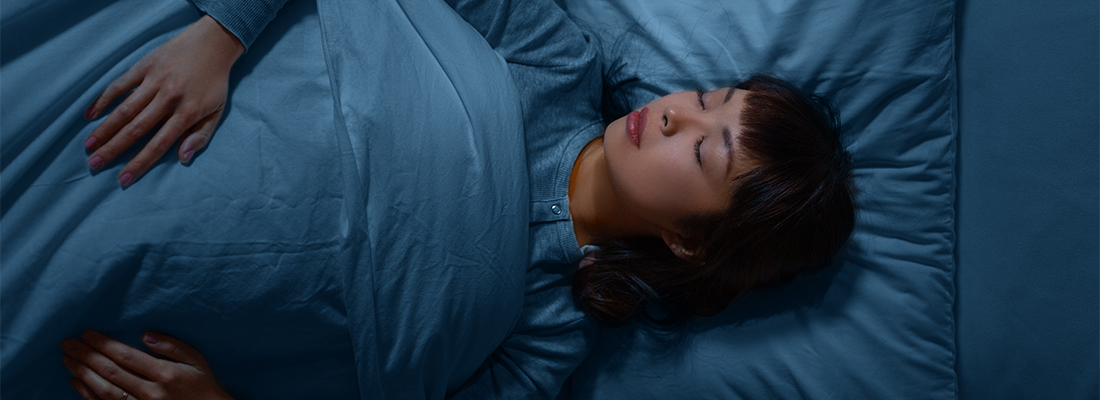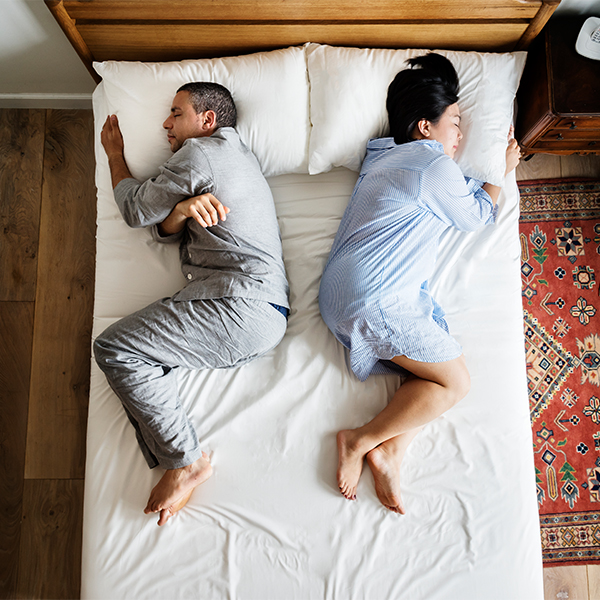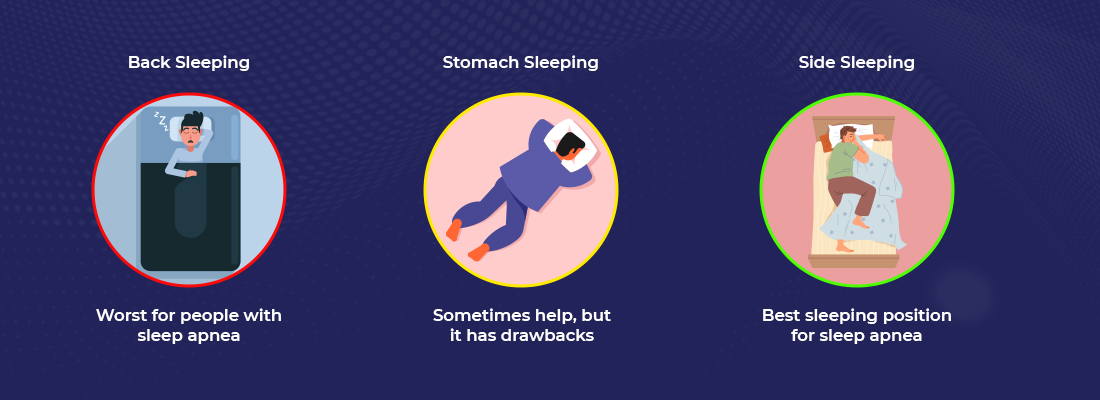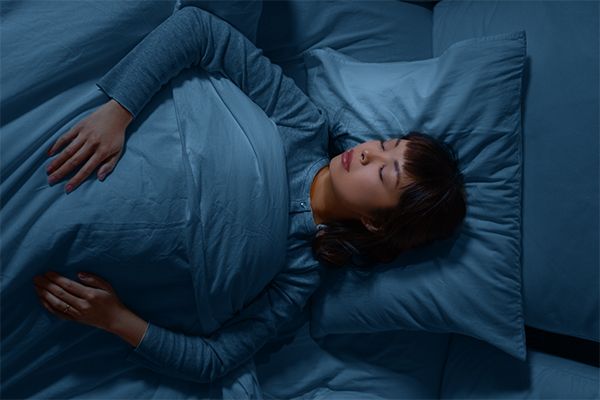
Introduction
Did you know that according to Standford Medicine, 12 million Americans are suffering from sleep apnea. You probably have sleep apnea if you are suffering from disrupted breathing during the night. It leads to poor sleep quality and multiple health risks. One of the best ways often overlooked is to adjust your sleep position. If you opt for the best sleeping position, it can greatly reduce the symptoms while the wrong position can make them worse.
This guide will enlighten you about the impact of different sleep positions on sleep apnea. It enlightens about the best sleep positions and highlights the worst positions to avoid. So, stay with us.
What is Sleep Apnea?
Sleep apnea is a disorder where breathing repeatedly stops and starts during sleep. There are two main types:
- Obstructive Sleep Apnea (OSA): The most common form, where the throat muscles relax excessively, blocking the airway. Additionally, weight loss might aid in reducing the symptoms of OSA.
- Central Sleep Apnea (CSA): A condition where the brain fails to send proper signals to the muscles that control breathing.
Symptoms of sleep apnea include loud snoring, gasping for air during sleep, daytime fatigue, and difficulty concentrating. Untreated sleep apnea can lead to serious health problems such as high blood pressure, heart disease, and diabetes.
One of the simplest ways to improve sleep apnea symptoms is to find the best sleeping position for sleep apnea. The way you sleep can directly affect airway obstruction, making it easier or harder to breathe during the night. Moreover, there are efficient sleep services available for sleep apnea. Find a reliable service near you and book your appointment today.
The Best Sleeping Position for Sleep Apnea
If you’re looking for the best sleeping position for sleep apnea, side sleeping is the top choice. Here’s why:
- Keeps the Airway Open – When you sleep on your side, gravity does not pull your tongue and throat tissues backward, reducing the likelihood of airway obstruction.
- Reduces Snoring – Many people with sleep apnea also snore loudly, and side sleeping minimizes this by allowing better airflow.
- Improves Oxygen Levels – Better airflow means more oxygen reaches the brain and body, leading to more restful sleep.
Left vs. Right Side Sleeping: Which is Better?
Both sides offer benefits, but left-side sleeping is generally considered the best sleeping position for sleep apnea.
Left side sleeping improves blood flow and reduces acid reflux, which is beneficial for people with both sleep apnea and GERD.
Right-side sleeping is still better than sleeping on your back but may not be as effective as the left-side.
If you’re not used to sleeping on your side, try these tips:
- Use a body pillow to support your position.
- Place a pillow behind your back to prevent rolling onto your back.
- Invest in a wedge pillow to elevate your head and further reduce airway obstruction.

The Worst Sleeping Position for Sleep Apnea
Just as some sleep positions help with sleep apnea, others make it worse. The worst sleep apnea sleeping position is sleeping on your back.
Why is Back Sleeping Bad for Sleep Apnea?
- Gravity Works Against You – The tongue and soft tissues collapse into the airway, increasing the chances of airway blockage.
- Higher Apnea Severity – Studies have shown that sleep apnea episodes are more frequent and severe when sleeping on the back.
- Increased Snoring – Snoring worsens due to restricted airflow, further disrupting sleep.
If you’re a habitual back sleeper, you can train yourself to sleep on your side by:
- Wearing a backpack with a soft pillow inside to make back sleeping uncomfortable.
- Using positional therapy devices that vibrate when you roll onto your back.
- Raising the head of your bed slightly to reduce airway collapse.
Is Stomach Sleeping a Good Alternative?
Stomach sleeping can sometimes help with sleep apnea by preventing the tongue from blocking the airway. However, it has downsides:
- Neck and Back Strain – Turning your head to breathe can cause discomfort and misalignment.
- Breathing Issues – If your face is pressed into the pillow, it may restrict airflow.
While stomach sleeping is better than back sleeping, side sleeping remains the best sleeping position for sleep apnea. Try it out and you will know.
Struggling with Sleep Apnea?
Discover a convenient and effective way to manage your sleep apnea without leaving your home.
Impact of Sleep Position on Sleep Apnea
our sleep position plays a vital role in how well you breathe at night. Some positions promote better airflow, while others cause airway collapse, worsening sleep apnea symptoms. Research has shown that body position can influence the severity of sleep apnea episodes.

- Back sleeping (supine position) is the worst for people with sleep apnea because gravity pulls the tongue and soft tissues backward, blocking the airway.
- Side sleeping is widely recommended as the best sleeping position for sleep apnea since it keeps the airway open and reduces snoring.
- Stomach sleeping can sometimes help, but it has drawbacks, such as neck strain and discomfort.
Finding the ideal sleep apnea sleeping position can make a noticeable difference in your sleep quality and overall health.
Additional Tips for Better Sleep with Sleep Apnea
Apart from finding the best sleeping position for sleep apnea, here are other strategies to improve your sleep quality:
- Use a CPAP Machine – Continuous Positive Airway Pressure (CPAP) therapy keeps airways open by providing a steady stream of air. However, there are treatment options available in addition to CPAP therapy, which pose a more comfortable option.
- Lose Excess Weight – Extra weight can put pressure on the airway, worsening sleep apnea.
- Avoid Alcohol and Sedatives – These relax throat muscles, increasing the risk of airway collapse.
- Sleep on an Adjustable Bed – Elevating your upper body can further reduce airway obstruction.
- Practice Good Sleep Hygiene – Maintain a consistent sleep schedule and create a relaxing bedtime routine.
Final Thoughts
To conclude, finding the best sleeping position for sleep apnea can make a main difference in managing symptoms and improving sleep quality. Side sleeping, especially on the left side, is the most effective position, as it keeps the airway open and reduces snoring. On the other hand, back sleeping is the worst because it leads to airway collapse and more severe apnea episodes.
If you suffer from sleep apnea, making small changes to your sleep position, along with using other treatment methods like CPAP therapy and lifestyle adjustments, can help you breathe easier at night. Start experimenting with your sleep position today and experience the benefits of better rest.
Moreover, Home Sleep Center is your trusted platform for providing telehealth services with a team of experts. Here, our user-friendly services and accurate sleep diagnostics collaborate to improve your overall sleeping experience. Contact us today.
Ready to Take Control of Your Sleep?
Book your appointment today and start your journey toward better sleep health.

